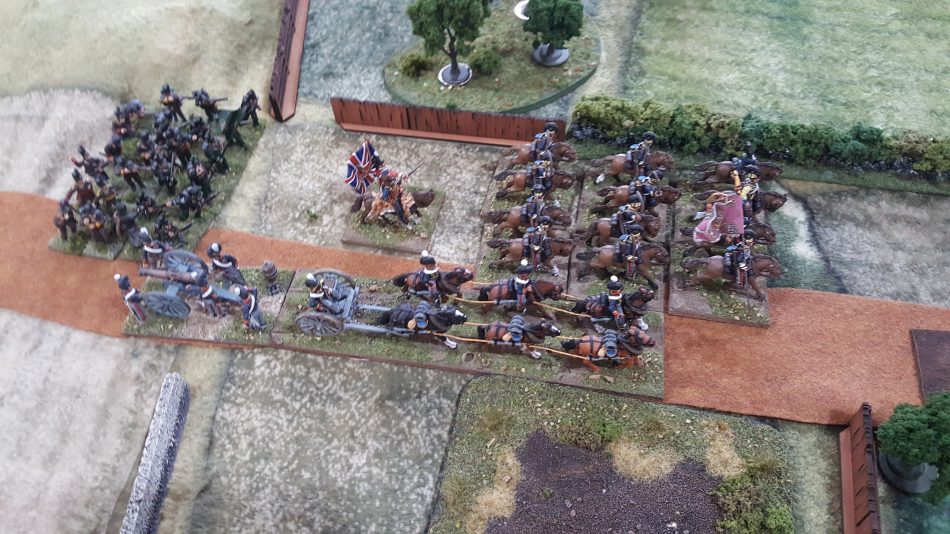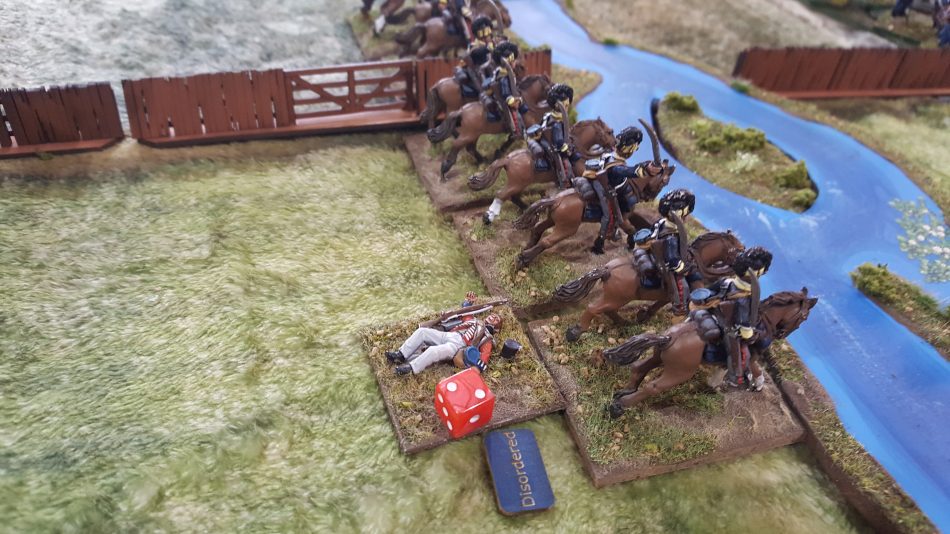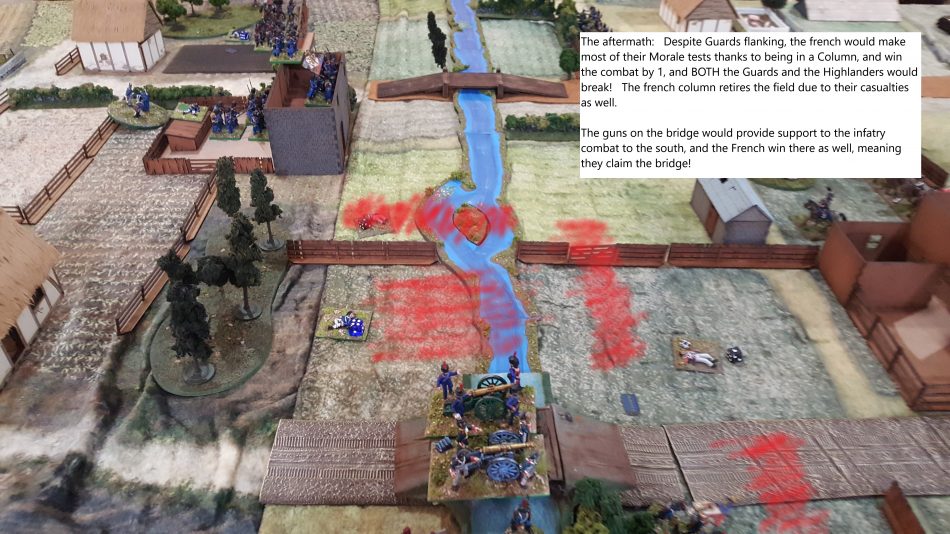Black Powder: Napoleonics
By Dennis “Matt Varnish” Campbell
Napoleon. Stop me if you’ve heard this one before: “Man takes over country, then takes over Europe, and has grand ideas of marching to Moscow, but is then thwarted by logistics and winter”
Scott’s place on a Saturday, with some Sharpe’s Rifles on the teleNapoleonics? Why? Well, for me with my gaming background starting mainly with sci-fi and fantasy (Games Workshop) I had never really looked at historicals, and certainly not Napoleonics. I knew who Napoleon was, and the era, mainly from watching Sharpe’s Rifles, a series where A: Sean Bean’s character doesn’t die, and B: Has Elizabeth Hurley in it (see header pic)
I had always wanted to paint some Napoleonic figures since they look flamboyant, and when well-painted, look great. I bought some guns, cavalry and infantry for a Kings of War force that went nowhere. A year later when I bumped into my buddy Scott at a tournament in Kingston, he was picking up some 28mm Perry plastics. We chatted and boom, we were into Napoleonics faster than you can say Voltiguer!
As you can imagine with anything Historical, there is a tonne of different rule-sets at different gaming and model scales. We decided on , primarily because this rule-set has the same underpinnings as Hail Caesar, Pike and Shotte, and from what we were told, was at a quicker pace and was less granular than other rulesets (IE, there isn’t 100 charts to consult for every eventuality, like if the wicks are dry after last night’s rain, roll 2d10)
Black Powder covers a basic time period and not one type of battle, starting from the end of the Pike and Shot era right up to the end of the 19th century, (before machine guns) so you could fight the Zulu Wars, Napoleonics, or the US Civil War. There are sourcebooks (with scenarios and more importantly, points values and special theatre specific rules) for these.
UNITS
As a civilian, I did not know the differences between a Company, Brigade, Battalion, Division, etc… so had to be educated. Each stand of models (we have based ours four infantry to a 40mm x 40mm base) represents a company. Each Battalion normally has six companies… four center companies and two flanking companies. Since I play the French, I had to learn that the flank companies were usually one Grenadier Company (veterans) and one Voltigeur Company.
A brigade is made up of a number of Battalions, led in Black Powder by a commander. Each unit can be given orders by this commander, or more typically, the whole Brigade receives the same order. A brigade can have a mix of units, such as Infantry, Cavalry, Guns of various types. In the French system which was imposed on quite a few of their ‘allies/subjects’, a Regiment is two Battalions.
A Division would be a number of Brigades led by a General. This is what we were using, each having a Division led by an over-all commander (who can issue orders to anyone) and three Brigades each with their own sub-commander.

FORMATIONS
Formations are an important part of Black Powder, as there are certainly advantages and disadvantages to each. As the French, if our units are in Attack or Mixed Column, we get an additional +1 on top of the usual +1 for being in a column for Orders. So +2 on orders given means that this is the default formation for most of my units. They also get +1 on Morale saves (think armour saves, but called Morale for some reason) but are more vulnerable to Artillery, since they are clumped together nicely.
British special rules tend to favour shooting (Thin Red Line and all that) so they would typically be in Line formation to take advantage, but perhaps start in Column to move into position first. Since changing formations is one Move when issuing orders, if you fail the order, it can mean sitting there firing only 1 shooting dice, as you will see further down.
Enough of the “parle-parle, jase-jase”, let’s get into the game:
THE GAME
We were playing using the Albion Triumphant sourcebook, which has rules and points for the Peninsular Wars, British army and their allies vs France and her allies/subjects. We played roughly 500 points per side, with three Brigades in each army.
I was rocking the Ultramarines of the Napoleonic era: The French, while Scott was using the British and their allies, and included the 95th Rifles (Sharpe’s unit in the books and TV Series) Two notable changes we made was deploying from off-board using Orders, and alternating Brigades instead of one full side, then the other getting their moves. Black Powder really encourages your own modifications to the rules, so this isn’t way off base.
After the first turn, French Cav Brigade advances, all infantry move up at a snail’s pace. 95th Rifles and British Cavalry overwatch the first objective: Bridge crossing.
My battery of Horse Artillery advance to the hilltop but were unable to Unlimber. Dragoons move up next to them, in case any British Highlanders get any ideas.
Meanwhile, my Infantry plods forward. Only because they were in Assault Column and are French were they even able to move since I failed this Brigadier’s command roll by 2. The round bases are commanders, they do not fight but can move and issue orders, Rally troops, etc.My 3rd Brigade, the Guards, advance through the difficult ground while their Gun is able to unlimber, looking down the road to the British gun sitting by the bridge.
Guard battalion, led by an officer on a horse, with Skirmisher screen in front, advance over hedges into a forest at slow pace.

Highlanders and other Elite troops advance the center of the British, still in Column formation due to the movement bonuses, once in range, he would issue Form Line orders to take advantage of the British special rules for shooting
Portuguese, Lusitanians and Brunswickers advance and the gun facing the wrong way means it is still Limbered.
Guard gun takes a tentative shot at the British Cavalry 40 inches out, but need a 5+ to hit, and miss.
My first order of Turn 2 was to the Cavalry Brigade, who roll double 6 for the Command Roll. Blunder chart, says that everyone makes one full move forwards. As my Horse Artillery had not unlimbered, it meant they moved 18 inches like the Dragoons! The river stops them within musket shot of the British Allied Brigade!
Meanwhile, my Imperial Guard makes it to the farm buildings and open up on the British Lt Cavalry, Disordering them and causing a wound on the unit (most units take a break check after 3 wounds) Pardon my ‘special’ smoke effects!
Luckily for me, Scott needed two moves to move up, then deploy into Line Formation. He only made one, and had to settle for one dice of shooting from each unit only, which caused a wound on each Dragon unit. That could have been worse for my troops.
At the top of this pic is my Cav in his face, while my Center advances from right of map towards that bridge, while in the foreground my Guards do not want to move up past those buildings otherwise face accurate fire from the 95th Sharpe’s Rifles.

En L’Avance! I tried to flank charge a unit in that forest, who Evaded (and they call the French Cowards) while my foot guns park on the bridge objective.
This time I get the 6+ needed to hit the British gun and Disorder it. The local cows don’t seem fussed by the racket.
The British form into Line and open fire. Luckily Scott’s dice are cold and my units take a beating but do not break.
The British view of the main battle, Allied Brigade on the left, Highlanders in the middle. Offscreen to the lower right the 95th Rifles are keeping my Guard pinned down.
I have a foreign unit of my own: Badeners with their yellow banner. The Confederation of the Rhine were ‘encouraged’ to supply troops to Napoleon’s army after a treaty signing. Here they are with Skirmish screen out, trying to cross the river.
I foolishly form a line with my Guards to bolster my line infantry, but they would get cut down by fire.
After Scott destroys my Guard, his center Highlander Brigade declare a multi-charge: Flank charge and frontal charges, to deny me Supporting units. The odds were against the French…..

With my laggard Light Infantry finally showing up the river and providing supporting fire, the British could not mount a counter-attack and I hold one Bridge Objective.
Scott at least tried to whittle me down and break my Cavalry. My Dragoons, with 3 wounds, pass their Morale, the Badeners only suffer 2 and stay on the battlefield.
The battle would end with one Bridge contested (95th vs my last Guard Battalion) but with my Line Infantry and Guns holding the other. Triomphe Napoleon! Hope you guys enjoyed it, and I will do some more articles on assembling my second Division: Confederation of the Rhine troops.
Check out , and share your own experiences playing Black Powder.
Matt Varnish, AKA Dennis Campbell, plays Team Yankee, Flames of War, and Black Powder in the frozen wastes of Canadia. Check out my youtube channel for hundreds of :

Great article and Scott has done a fantastic paint job. Thanks.
Thanks Bob
Great article and great game, thanks Dennis. While you work on your Confederation of the Rhine I will finish off the rest of the Brunswickers and think about getting my Russians started.
Great article, looks like a good game to get into.
All round great!!! Terrain review and game!!! Loved the Sharpe thing.
Excellent!
Good intro into the game. I have the rules on the shelve here at home, but never managed to take the leap into it. How many models do I need to get ready to have real taste of how it works?
Its not that much really, if you’ve ever done a Warhammer Fantasy army, its the same.. but to get a taste, you could always do a Brigade vs Brigade , ignore the Brigade Break rules, and move each battalion under orders, and not do multiple battalions per order.